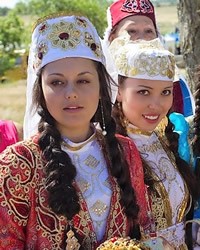Throughout history, Armenia has been a battlefield for many invaders and contending empires, and a bridge for many cultures and civilizations. During the past 2,700 years, Armenia has been conquered by the Persian Empire, Alexander the Great, the Roman Empire, the Byzantines, Arabs, Mongols, Tatars, Ottomans, Persians, and Russians. Armenian kingdoms, principalities, and even a short-lived empire (95-55 B.C.) managed to survive and thrive for some 1,700 years. Under various kings and princes, the Armenians developed a sophisticated culture, an original architecture, and their own alphabet.The 1905 Russian revolution and the 1908 Young Turk revolution raised the hopes of the Armenians for reform and an opportunity to build a homeland in historical Armenia. These hopes were dashed as the Ottoman and the Russian Empires fought each other during World War I. A dark hour of Armenian history is the Armenian genocide, which started on April 24, 1915. Some 1,750,000 Armenians were deported to Syria and Mesopotamia by the Ottoman authorities. Subject to famine, disease, and systematic massacres, most of them perished. This "ethnic cleansing" of the Armenians from their historical homeland led Raphael Lemkin, the father of the Genocide Treaty, to coin the new term "genocide" in the 1930s to describe the historical plight of the Assyrians and the Armenians as subjects of the first genocide of the 20th century. Armenia gained independence on September 23, 1991.Today, there are several million Armenians worldwide. Significant numbers are located in Armenia and the United States of America. Major diaspora centers of the Middle East are Iran, Syria and Lebanon. There are also Armenian communities is some of the European and Latin American countries such as Argentina.
Argentina is home to one of the largest Armenian diaspora communities globally. The community's roots trace back to the early 20th century, after the massacres and genocide in the Ottoman Empire. The majority of the Armenians live in Buenos Aires, where there is a district named ‘Little Armenia', centered with Armenian churches, cultural centers, restaurants, and schools. The city is filled with significant Armenian infrastructures and monuments.By the 1970s, Armenians significantly impacted Argentina's economy – controlling roughly one-third of the textile industry, 50% of rugs, and 10% of the shoe industry. Aside from this, Armenians are known in the work field as lawyers, doctors, journalists, artists, scientists, and politicians. With the population being so big and influential in Argentina, it hasn't been difficult for Armenians to uphold their culture through churches, schools, sports clubs, choirs, theater groups, and cultural centers supported by Armenian organizations.Alongside a district named after Armenia, Buenos Aires features parks honoring Armenian heritage. Families gather every year on the 24th of April to commemorate the genocide with marches, ceremonies, cultural activities, and formal government recognition. Even though they are far from their motherland, their hearts are still rooted in Armenia – with community advocates organizing protests and humanitarian aid for Armenia yearly.Argentina has created a safe and welcoming home for the Armenians to live, flourish, and give back to community – launching the ‘Armenian Buenos Aires' initiative to highlight Armenian contributions in culture, economy, and public life.
In 301 AD, during the rule of King Dirtad III, Armenia became the world's first Christian nation. A Christian monk, commonly known as Krikor Lusavorich or St. Gregory the Illuminator, cured the King from a disease. After this event, King Dirtad III was baptized and accepted Christianity as Armenia's official state religion. Before this, two disciples had brought Christianity to Armenia, St. Thaddeus and St. Bartholemew.Spiritually, Armenians are still Christian, but their faith in Christ has often taken the back seat to nationalism or a faith in their heritage. Every generation needs a fresh work of the Holy Spirit to move them to full devotion to Jesus Christ.
Armenians need the Holy Spirit to move in their families and their churches so they can enjoy the abundant life that only Jesus offers.
Pray for the Armenians in Argentina to be salt and light to those who don't know the only Savior.Pray for spiritual peace; this is what Armenia needs most of all.Pray that God would bring revelation of Christianity as a spiritual relationship, and that Armenians would realize they can have joy and peace as they follow the Lord.Pray for their businesses to flourish as a testimony of God's power and goodness.Pray that they would see the work of God's grace in their lives.Pray that God would open their eyes to seek his love and comfort during life's trials and blessings.
Scripture Prayers for the Armenian in Argentina.
Middle East Resourceshttps://en.wikipedia.org/wiki/Armenian_Argentineshttps://agbu.org/ola-buenos-aires/armenians-argentinahttps://trailo.am/argentina/armeniansenhttps://heyarmenia.com/en/blog/Small%20Armenia%20in%20Argentinahttps://armenianweekly.com/2025/08/12/how-jrimian-armenian-school-revolutionized-human-rights-education-in-argentina/https://www.armeniandiasporasurvey.com/argentinahttps://baec.aua.am/files/2020/09/Vicky-Melkonyan_Belonging.-Argentine-Armenians-About-Their-Dual-Identity-1.pdfhttps://agbu.am/ola-buenos-aires/quantum-leap-second-generationhttps://agbu.org/argentina-brazil-uruguay/home-extended-armenian-familyhttps://armenianweekly.com/2025/05/08/the-110th-anniversary-of-the-armenian-genocide-commemorated-across-south-americahttps://armenpress.am/en/article/218709
| Profile Source: Joshua Project |












